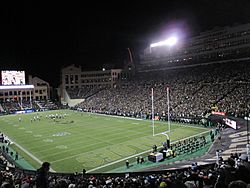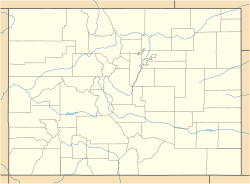Folsom Field facts for kids

Sold out night game with Utah in 2016
|
|
| Former names | Colorado Stadium (1924–1944) |
|---|---|
| Address | 2400 Colorado Avenue |
| Location | University of Colorado Boulder, Colorado, U.S. |
| Coordinates | 40°00′32″N 105°16′01″W / 40.009°N 105.267°W |
| Elevation | 5,360 feet (1,635 m) AMSL |
| Owner | University of Colorado |
| Operator | University of Colorado |
| Capacity | 50,183 (2014–present)
Former capacities: List
|
| Record attendance | 54,972 |
| Surface | Natural grass (1924–1970, 1999–present) AstroTurf (1971–1998) |
| Construction | |
| Broke ground | January 14, 1924 |
| Opened | October 11, 1924 |
| Renovated | 1968, 1976, 2003 |
| Expanded | 1956, 1967, 2003 |
| Construction cost | $65,000 (1924) |
| Architect | Waldo E. Brockway Sink Combs Dethlefs (renovations) |
| Tenants | |
| Colorado Buffaloes (NCAA) (1924–present) | |
Folsom Field is an outdoor college football stadium. It is located on the campus of the University of Colorado in Boulder, Colorado. This stadium is the home field for the Colorado Buffaloes team. They play in the Big 12 Conference.
The stadium first opened in 1924. It has a special horseshoe shape that opens towards the north. The university's sports office, named after a coach called Dal Ward, is at the north end.
The playing field is made of natural grass. It sits very high up, at about 5,360 feet (over a mile) above sea level. Folsom Field is one of the highest college football stadiums in the FBS. Only stadiums in Wyoming and Air Force are higher.
Contents
History of Folsom Field
Before Folsom Field, the Colorado football team played at Gamble Field. Folsom Field opened as Colorado Stadium on October 11, 1924. It has been the home of the Buffaloes football team ever since. The team has a strong winning record at home.
The stadium was renamed Folsom Field in 1944. This was done to honor former head coach Fred Folsom. He coached the team for fifteen seasons and had a great record. The official renaming happened during the homecoming game in 1946.
In 2008, Folsom Field became the first "zero-waste" stadium in the NCAA. This means they started a big program to recycle and compost almost all their trash.
How Folsom Field Grew: Expansions and Renovations
When Folsom Field first opened in 1924, it could hold 26,000 people. A big expansion in 1956 made the stadium taller and increased the seating to 45,000. In 1967, a running track was removed, adding another six thousand seats. The track and field team moved to a new place called Potts Field.
In 1968, a large, six-story press box was built on the west side. This is where reporters and broadcasters sit. Later, in 1976, the old wooden seats were replaced with new aluminum ones. This brought the stadium's capacity to 52,005.
More changes happened in 2003. Luxury suites and special club seating areas were added to the east side. This increased the capacity to 53,750. A few seats with blocked views were later removed, making the capacity 53,613.
In 2014, more construction began. This included a new indoor practice area and a high-performance sports center. Extra seating was also added in the northeast corner. Before the 2016 season, the north endzone was completely rebuilt. It now has large boxes and club-level seating.
The most recent update was before the 2024 season. The video board in the south endzone was replaced with a much larger one. It is now five times bigger than the old one!
The Playing Surface: Grass or Turf?
From 1924 until 1970, Folsom Field had natural grass. In the summer of 1971, AstroTurf was installed. The first game on the new turf was a big win against Wyoming. The synthetic turf was replaced again in 1978 and 1989.
After 28 years of AstroTurf, Folsom Field returned to natural grass in 1999. This project cost $1.2 million and included special heating and drainage systems.
In March 2025, Colorado announced another change. The natural grass surface will be replaced with AstroTurf 3D3 for the next season. This change helps Folsom Field host the College Football Playoff in winter. It also makes it easier to host concerts outside of summer. The new turf is expected to be ready by July 1.
Other Fun Events at Folsom Field
Folsom Field isn't just for football! It also hosts other exciting events.
Concerts at the Stadium
Many famous bands have played concerts here. The Grateful Dead played several times, including in 1972 and 1980. The Rolling Stones also performed in 1978 and 1981.
The Dave Matthews Band had a concert here in 2001. It was even recorded for an album and DVD! After that, no concerts were held for fifteen years.
More recently, Dead & Company has played many shows at Folsom Field. They hold the record for the most performances at the venue, with 13 shows. Other artists like Tyler Childers and Odesza have also performed. In 2025, Phish and John Summit are scheduled to play.
Other Special Events
Folsom Field is the finish line for the Bolder Boulder. This is a very popular 10K running race. The first Promise Keepers stadium conference was also held here in 1992.
Record-Breaking Crowds
The biggest crowd for a Colorado Buffaloes football game at Folsom Field was 54,972 people. This happened in 2005 during a game against Colorado State. The Buffaloes won with a last-minute field goal!
The largest crowd ever at Folsom Field was for a rock concert in 1977. An estimated 61,500 people came to see bands like Fleetwood Mac and Bob Seger.
| Rank | Attendance | Date | Game Result |
|---|---|---|---|
| 1 | 54,972 | September 3, 2005 | Colorado 31, Colorado State 28 |
| 2 | 54,954 | September 4, 2004 | Colorado 27, Colorado State 24 |
| 3 | 54,841 | November 25, 2005 | Colorado 3, Nebraska 30 |
| 4 | 54,646 | November 16, 2024 | #17 Colorado 49, Utah 24 |
| 5 | 54,215 | October 25, 2003 | Colorado 20, #1 Oklahoma 34 |
Images for kids
See also
- List of NCAA Division I FBS football stadiums
- List of American football stadiums by capacity
- Lists of stadiums














